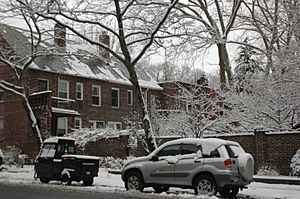Sunnyside Gardens, Queens facts for kids
Sunnyside Gardens is a special community in Sunnyside, a neighborhood in Queens, New York City. It was the very first place in the United States built using ideas from the "garden city movement." This idea started in England in the early 1900s. It was inspired by places like Hampstead Garden Suburb and Letchworth Garden City.
Sunnyside Gardens covers about 77 acres of land. It is located between Queens Boulevard and Sunnyside Yard. It was built between 1924 and 1928. The City Housing Corporation created it. This group was started by a developer named Alexander Bing. The main architects were Clarence Stein and Henry Wright. This project came from talks in the 1920s about how to build better homes. Lewis Mumford was an important person in these discussions. Sunnyside Gardens is one of the first planned communities in the U.S.
Today, Sunnyside Gardens is listed as a historic district. This means it is a special area protected for its history. Both the National Register of Historic Places and the New York City Landmarks Preservation Commission recognize it.
Contents
What is Sunnyside Gardens Like?
Sunnyside Gardens was built from 1924 to 1928. It covers about 16 city blocks. There are more than 600 buildings in the area. It has many special courts, like Carolin Gardens and Roosevelt Court. The community is in the northwestern part of Queens.
The main architects for Sunnyside Gardens were Clarence Stein and Henry Wright. Frederick L. Ackerman designed some of the smaller "mews" houses. The landscape architect, who designed the outdoor spaces, was Marjorie Sewell Cautley.
Homes and Gardens
The homes in Sunnyside Gardens are made of brick. They include one, two, or three-family houses. There are also a few apartment buildings. Each private house has a small garden in the front, facing the street. They also have a private garden in the back. The apartments in the two and three-family houses have private terraces. These terraces look out over the gardens.
There are two main types of homes here. Some homes are built around a shared inner courtyard. This courtyard is a common green space. It is landscaped but not used for playing. Other homes are "mews" houses. These face a common front court. They also have a private backyard. This design allowed for many homes to be built close together. But it still gave everyone lots of green space.
Community Parks
The City Housing Corporation also set aside land for a private park. This park is on the northern edge of the community. It is one of only two private parks in New York City. The other one is Gramercy Park.
History of Sunnyside Gardens
Sunnyside Gardens was the first place in the U.S. built on the "garden city" idea. This idea came from England in the early 1900s. It was started by people like Ebenezer Howard and Raymond Unwin. They wanted to create communities with lots of green space.
The community was built between 1924 and 1928. It was created by the City Housing Corporation. This group was founded by Alexander Bing. The architects were Clarence Stein and Henry Wright. Important thinkers like Lewis Mumford and Richard T. Ely were part of the early discussions.
Protecting the Community
During the Great Depression, many families struggled. Some nearly lost their homes. But residents worked together to protect their community.
For 40 years, special rules called "easements" protected Sunnyside Gardens. These rules kept the courtyards and walkways safe. They also controlled changes to the outside of the homes. This even included paint colors. These rules ended in the mid-1960s. Some homeowners then tried to claim parts of the shared courtyards.
To protect the area, the city stepped in. In 1974, Sunnyside Gardens became a "special planned community preservation district." This meant new rules were put in place. These rules protect the inner courts and landscaping. They also stop people from building driveways or sheds in certain areas.
Why Sunnyside Gardens is a Landmark
The Sunnyside Gardens Historic District is a national historic district. It includes 66 important buildings and 12 sites. It was added to the National Register of Historic Places in 1984. It also became a city historic district in 2007.
Becoming a City Landmark
In 2003, people in the community started a movement. They wanted Sunnyside Gardens to become a New York City Historic District. This was to help protect the historic look of their homes. The campaign got a lot of attention. News outlets like WNYC and The New York Times covered it.
On April 17, 2007, the New York City Landmarks Preservation Commission (NYCLPC) held a public meeting. Many people spoke for and against the idea. This was even talked about on New York Public Radio. On June 26, 2007, the NYCLPC voted to make Sunnyside Gardens a city landmark. This means that most big changes to the homes need approval from the NYCLPC. This helps keep the community's special look and history safe.


